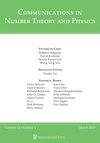Berglud–Hübsch Landau–Ginzburg轨道褶皱的椭圆属
IF 1.7
3区 数学
Q1 MATHEMATICS
引用次数: 0
摘要
镜像对称最初被表述为N =(2,2)超共形场理论之间的对应,该对对地构造了一个Calabi-Yau N -fold X和它的镜像伙伴X。在上同调群水平上,Hodge菱形有一个90度旋转,即hp,q(X,C) = hn−p,q(X,C)Batyrev在与一对自反多面体相关的Gorenstein Fano toric变种中构建的Calabi-Yau超曲面([B])是镜像Calabi-Yau变种实例的丰富来源。该构造后来由Borisov推广到Gorenstein Fano环变种中的Calabi-Yau完全交([B1]),并由Batyrev和Borisov进一步推广到自反Gorenstein锥的镜像对偶([BB1])。他们证明了由他们的构造产生的(奇异)Calabi-Yau变体的弦论Hodge数满足预期的镜像对偶性([BB2])。大约在同一时间,物理学家Berglund和h本文章由计算机程序翻译,如有差异,请以英文原文为准。
Elliptic genera of Berglund–Hübsch Landau–Ginzburg orbifolds
Mirror symmetry was originally formulated as a correspondence between the N = (2, 2) superconformal field theories constructed for a Calabi-Yau n-fold X and for its mirror partner X∨. On the level of cohomology groups, there is a 90-degree rotation of the Hodge diamond, i.e. hp,q(X,C) = hn−p,q(X∨,C). Batyrev’s construction of Calabi-Yau hypersurfaces in Gorenstein Fano toric varieties associated to a pair of reflexive polytopes ([B]) is a prolific source of examples of mirror Calabi-Yau varieties. This construction was later generalized by Borisov to Calabi-Yau complete intersections in Gorenstein Fano toric varieties ([B1]), and further by Batyrev and Borisov to the mirror duality of reflexive Gorenstein cones ([BB1]). They proved that the stringtheoretic Hodge numbers of (singular) Calabi-Yau varieties arising from their constructions satisfy the expected mirror duality ([BB2]). Around the same time, physicists Berglund and Hübsch proposed a way to construct mirror pairs of (2, 2)-superconformal field theories in the formalism of orbifold Landau-Ginzburg theories ([BH]). They considered a nondegenerate invertible polynomial potential W whose transpose W∨ is again a non-degenerate invertible potential. They claimed that there exists a suitable group H such that the Landau-Ginzburg orbifolds W and W∨/H form a mirror pair. Recently, Krawitz found a general construction of the dual group G∨ for any subgroup G of diagonal symmetries of W , and proved an “LG-to-LG” mirror symmetry theorem for the pair (W/G,W∨/G∨) at the level of double-graded state spaces ([K]). Under a certain CY condition, the polynomials W , W∨ define CalabiYau hypersurfacesXW ,XW∨ in (usually different) weighted projective spaces.
求助全文
通过发布文献求助,成功后即可免费获取论文全文。
去求助
来源期刊

Communications in Number Theory and Physics
MATHEMATICS, APPLIED-MATHEMATICS
CiteScore
2.70
自引率
5.30%
发文量
8
审稿时长
>12 weeks
期刊介绍:
Focused on the applications of number theory in the broadest sense to theoretical physics. Offers a forum for communication among researchers in number theory and theoretical physics by publishing primarily research, review, and expository articles regarding the relationship and dynamics between the two fields.
 求助内容:
求助内容: 应助结果提醒方式:
应助结果提醒方式:


